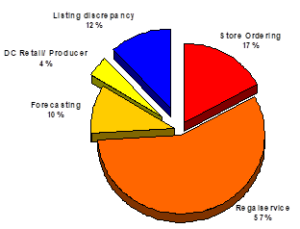There is considerable potential for reducing inventory in the German retail sector. High stock levels in the central warehouses and in the stores cover up weak points in the processes that cause bottlenecks, out-of-stocks and delivery delays.
On average, 13 percent of retail sales are tied up in inventories. This results in an inventory range of well over a month. There is considerable cost-cutting potential here, but this is often not recognized.

A decisive argument against reducing stock levels in the retail sector is certainly the fact that, despite modern logistics and ECR (Efficient Consumer Response) systems, shelf gaps still occur frequently. However, studies show that the main causes of stock-outs are usually found on the last “ten meters” to the shelf. As a result, they cannot be improved by optimizing the supply chain or by increasing stocks upstream in the supply chain.
According to a European study, few consumers switch shopping locations when items are missing from the shelves; most choose an alternative product. However, 9 percent do not buy anything at all during a stockout. As a result, European food retailers, and therefore also manufacturers, lose over EUR 4 billion in sales every year due to items not being available on the shelves. In Germany, this non-purchase rate of 14% is even significantly higher than the European average.
Why do out-of-stocks occur? Studies show (e.g. OSA study Roland Berger 2003) that the area of “in-store logistics” (store ordering, shelf service) is a disproportionately high cause of errors. The most important causes here are
- lack of staff – inadequate shelf maintenance
- Poor warehouse organization
- Lack of shelf labels – Insufficient assortment implementation
- Incorrect book inventories
- Order triggered too late or not at all
This means that almost three quarters of shelf gaps are caused by internal store factors. 10 percent are attributable to the connected ERP system (scheduling and forecasting system) due to incorrect forecasts, excessive minimum order quantities or incorrect parameterization at article and supplier level. Only 4 percent of the shelf gaps analyzed are due to delivery errors by the manufacturer, and 12 percent are caused by listing discrepancies. These figures show that incorrect disposition mechanisms at manufacturers and retailers are responsible for only 14 percent of out-of-stocks. However, they are responsible for a good 80 percent of excess stocks.

Careful balancing
These figures show that high delivery readiness and low inventories are not contradictory, but are components of efficient inventory management that need to be adjusted individually. Increasing stocks in order to achieve delivery readiness is therefore rarely the necessary answer. In most cases it is even wrong. Further studies show that manufacturers and retailers who manage their supply chain efficiently achieve lower out-of-stock rates with lower inventories.
Improving delivery readiness and significantly reducing inventories are therefore not a contradiction in retail, but two necessary directions for securing and improving competitiveness. In order to achieve such goals, the entire supply chain from manufacturer to shelf must be carefully balanced. This includes, among other things:
- Assortment optimization through reduction of variants and SKUs (Stock Keeping Units)
- efficient forecasting and scheduling:
- Improving the accuracy of forecasts
- In the connected warehouse locations, the parameterization of the control variables of the scheduling and forecasting system must be optimized
- Synchronized data provision of POS and warehouse data by the suppliers
- Improving information sharing in the supply chain (Collaborative Planning, Forecasting and Replenishment (CPFR) – Retail Link)
- streamlined organizational mechanisms in logistics:
- Steadying the flow of goods by shortening order and delivery cycles and replenishment times
- the optimization of the relationship between flows of goods that run via inventory-managed distribution (warehousing) and flows of goods that run via inventory-free distribution (cross-docking)
- efficient KPI system with key performance indicators for monitoring the supply chain.
 It is not too little stock in the supply chain from the manufacturer to the retailer’s store, as is often assumed, but incorrect organizational processes in the stores that cause 70 percent of all availability problems on the shelves. On the contrary, inventories in the supply chain represent untapped potential for reducing working capital and lowering retail costs.
It is not too little stock in the supply chain from the manufacturer to the retailer’s store, as is often assumed, but incorrect organizational processes in the stores that cause 70 percent of all availability problems on the shelves. On the contrary, inventories in the supply chain represent untapped potential for reducing working capital and lowering retail costs.
In projects to analyze excess inventories, the consulting firm Abels & Kemmner has repeatedly demonstrated that up to 25 percent reduction in inventories can be achieved with the same level of delivery readiness simply by correctly parameterizing the control variables of the replenishment system. In the tough competition between retailers, the ability of companies to manage and monitor their inventories in the future will therefore become increasingly important. The 2004 annual report of the retail company Wal-Mart already stated: “If our inventories grow less than half as fast as our sales, this is a key indicator of our efficiency.” There is nothing to add to this.

